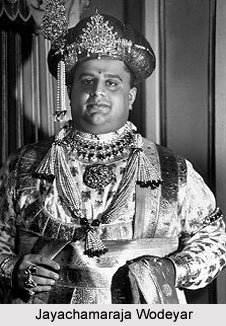 Jayachamaraja Wodeyar, popularly known as Jayachamaraja Wodeyar Bahadur was the 25th ruler or Maharaja of the princely state of Mysore. He was the last Maharaja who ruled the territory from the year 1940 to 1950. Jayachamaraja was also a renowned philanthropist, political theorist, musicologist and a reputed philosopher. He was born on 18th July 1919 in Mysore to the parents Yuvaraja Kanteerava Narasimharaja Wadiyar and Yuvarani Kempu Cheluvaja Amanni. He was born in the Royal Family of Mysore, who belongs to the lineage of Chandrvanshi Kshatriya or the Lunar Dynasty. The Maharaja successfully completed his graduation in 1938 from the Maharajas College in Mysore. He was honored with 5 awards and gold medals. Jayachamaraja was married on 15 May 1938 and in the next year he went to Europe and visited several associations in London, making acquaintance with various scholars and artists.
Jayachamaraja Wodeyar, popularly known as Jayachamaraja Wodeyar Bahadur was the 25th ruler or Maharaja of the princely state of Mysore. He was the last Maharaja who ruled the territory from the year 1940 to 1950. Jayachamaraja was also a renowned philanthropist, political theorist, musicologist and a reputed philosopher. He was born on 18th July 1919 in Mysore to the parents Yuvaraja Kanteerava Narasimharaja Wadiyar and Yuvarani Kempu Cheluvaja Amanni. He was born in the Royal Family of Mysore, who belongs to the lineage of Chandrvanshi Kshatriya or the Lunar Dynasty. The Maharaja successfully completed his graduation in 1938 from the Maharajas College in Mysore. He was honored with 5 awards and gold medals. Jayachamaraja was married on 15 May 1938 and in the next year he went to Europe and visited several associations in London, making acquaintance with various scholars and artists.
Rule of Jayachamaraja Wodeyar
After the demise of Maharaja Nalvadi Krishnaraja Wodeyar, his uncle, he took over the royal throne of the princely state of Mysore on 8th September 1940. On the eve of Indian Independence in August 1947, Jayachamaraja Wodeyar signed the Instrument of Accession with the Dominion of India. The princely state of Mysore was amalgamated with the Republic of India on 26th January 1950. From the year 1950 to 1956, he held the designation of Rajpramukh of Mysore state. After the incorporation of most parts of Madras and Hyderabad states and the neighboring Kannada, Jayachamaraja was appointed as the first Governor of the restructured and integrated state of Mysore (1956- 1964). Later he became the Governor of the State of Madras (Tamil Nadu) from 1964 to 1966.
Other Activities of Jayachamaraja Wodeyar
Maharaja Jayachamaraja Wodeyar was an excellent tennis player who provided support to tennis player to take part in Wimbledon. He was also a fine horseman and a renowned marksman. He also supported well known cricketer E.A.S. Prasanna to participate in a match in West Indies. Jayachamaraja. He was an aficionado of both South Indian classical music, particularly Carnatic music, as well as western music. He was also an acknowledged authority of Indian Philosophy. In the year 1945, he became an honorary Fellow of Trinity College of Music, London and a Licentiate of the Guild Hall of Music, London. Later in 1948, Jayachamaraja Wodeyar became the initial president of the Philharmonia Concert Society in London.
Literary Works of Jayachamaraja Wodeyar
Jayachamaraja Wodeyar also wrote several literary works such as, The Quest for Peace: An Indian Approach (1959); Dattatreya: The Way and The Goal (1957); The Gita and Indian Culture (1963); Religion and Man (1965); Avadhuta: Reason and Reverence (1958); An Aspect of Indian Aesthetics (1956); Puranas As The Vehicles Of India`s Philosophy Of History (1963); Sri Suresvaracharya (1970); Kundalini Yoga; The Virtuous Way of Life (1964) and others. Jayachamaraja also funded the translation of various classics from Sanskrit to Kannada which were included in the Jayachamaraja Grantha Ratna Mala. The ancient holy scriptures in Sanskrit were not available earlier in Kannada language.
Personal Life of Jayachamaraja Wodeyar
Maharaja Jayachamaraja Wodeyar had three sisters namely Princess Vijaya Lakshmi Ammani, Princess Sujaya kantha Ammani and Princess Jaya Chamunda Ammani Avaru. He was married to Maharani Sathya Prema Kumari of Charkhari on May 15, 1938. But the marriage did not work and thus the Maharaja got married for the second time to Maharani Tripura Sundari Ammani Avaru on 30th April 1944. The couple had 6 children named Princess Gayatri Devi Avaru, Princess Meenakshi Devi Avaru, Maharaja Sri Srikantha Datta Narasimharaja Wodeyar, Princess Indrakshi Devi Avaru, Princess Kamakshi Devi Avaru and Princess Vishalakshi Devi Avaru.
Titles of Jayachamaraja Wodeyar
Jayachamaraja Wodeyar held several titles through out his reign. These are mentioned below-
* Maharajkumar Sri Jayachamarajendra Wodeyar (1919- 1940)
* His Highness Yuvaraja Sri Jayachamarajendra Wodeyar Bahadur, Yuvaraja of Mysore (1940)
* His Highness Maharaja Sri Jayachamarajendra Wodeyar Bahadur, Maharaja of Mysore (1940-1945)
* His Highness Maharaja Sri Sir Jayachamarajendra Wodeyar Bahadur, Maharaja of Mysore, GCSI (1945-1946)
* His Highness Maharaja Sri Sir Jayachamarajendra Wodeyar Bahadur, Maharaja of Mysore, GCB, GCSI (1946-1962)
* Major-General His Highness Maharaja Sri Sir Jayachamarajendra Wodeyar Bahadur, Maharaja of Mysore, GCB, GCSI (1962-1974)
Honours of Jayachamaraja Wodeyar
Maharaja Jayachamaraja Wodeyar was honoured several times, these include-
* The British Government honored him with the GCSI (1945) and GCB (1946)
* Doctor of Literature from the University of Queensland, Australia
* Doctor of Literature from the Annamalai University, Tamil Nadu
* Doctor of Law from the Banaras Hindu University
* Doctor of Laws, honoris causa from University of Mysore (1962)
* Fellow and president of Sangeet Natak Academy (1966)
* First Chairman of the Indian Wild Life Board
* Founder President of the Vishwa Hindu Parishad



















